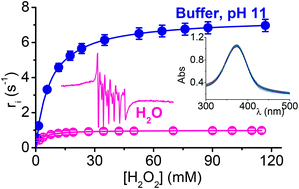Synthesis, characterization, and reactivity studies of a water-soluble bis(alkoxo)(carboxylato)-bridged diMnIII complex modeling the active site in catalase†‡
Abstract
A new diMnIII complex, Na[Mn2(5-SO3-salpentO)(μ-OAc)(μ-OMe)(H2O)]·4H2O, where 5-SO3-salpentOH = 1,5-bis(5-sulphonatosalicylidenamino)pentan-3-ol, has been prepared and characterized. ESI-mass spectrometry, paramagnetic 1H NMR, EPR and UV-visible spectroscopic studies on freshly prepared solutions of the complex in methanol and 9 : 1 methanol–water mixtures showed that the compound retains the triply bridged bis(μ-alkoxo)(μ-acetato)Mn23+ core in solution. In the 9 : 1 methanol–water mixture, slow substitution of acetate by water molecules took place, and after one month, the doubly bridged diMnIII complex, [Mn2(5-SO3-salpentO)(μ-OMe)(H2O)3]·5H2O, formed and could be characterized by X-ray diffraction analysis. In methanolic or aqueous basic media, acetate shifts from a bridging to a terminal coordination mode, affording the highly stable [Mn2(5-SO3-salpentO)(μ-OMe)(OAc)]− anion. The efficiency of the complex in disproportionating H2O2 depends on the solvent and correlates with the stability of the complex (towards metal dissociation) in each medium: basic buffer > aqueous base > water. The buffer preserves the integrity of the catalyst and the rate of O2 evolution remains essentially constant after successive additions of excess of H2O2. Turnovers as high as 3000 mol H2O2 per mol of catalyst, without significant decomposition and with an efficiency of kcat/KM = 1028 M−1 s−1, were measured for the complex in aqueous buffers of pH 11. Kinetic and spectroscopic results suggest a catalytic cycle that runs between MnIII2 and MnIV2 oxidation states, which is consistent with the low redox potential observed for the MnIII2/MnIIIMnIV couple of the catalyst in basic medium.


 Please wait while we load your content...
Please wait while we load your content...